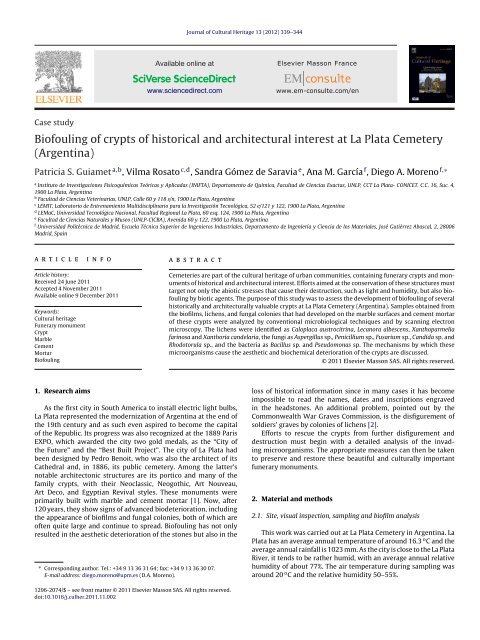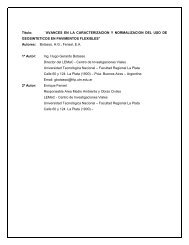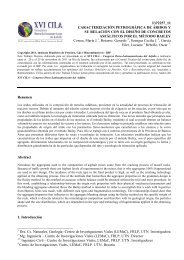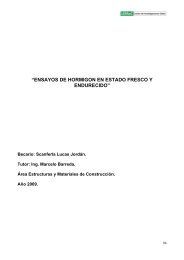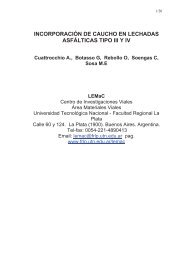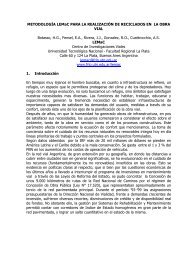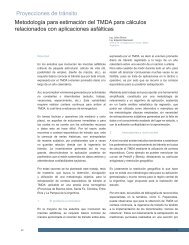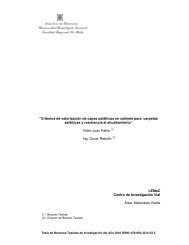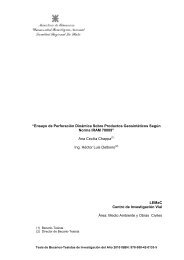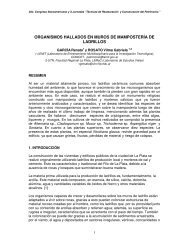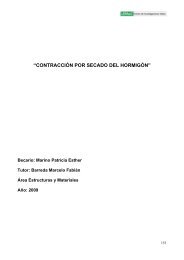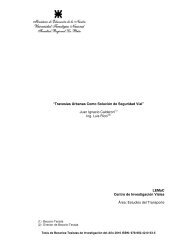Biofouling of crypts of historical and architectural interest at La Plata ...
Biofouling of crypts of historical and architectural interest at La Plata ...
Biofouling of crypts of historical and architectural interest at La Plata ...
You also want an ePaper? Increase the reach of your titles
YUMPU automatically turns print PDFs into web optimized ePapers that Google loves.
Case study<br />
Available online <strong>at</strong><br />
www.sciencedirect.com<br />
Journal <strong>of</strong> Cultural Heritage 13 (2012) 339–344<br />
<strong>Bi<strong>of</strong>ouling</strong> <strong>of</strong> <strong>crypts</strong> <strong>of</strong> <strong>historical</strong> <strong>and</strong> <strong>architectural</strong> <strong>interest</strong> <strong>at</strong> <strong>La</strong> Pl<strong>at</strong>a Cemetery<br />
(Argentina)<br />
P<strong>at</strong>ricia S. Guiamet a,b , Vilma Ros<strong>at</strong>o c,d , S<strong>and</strong>ra Gómez de Saravia e , Ana M. García f , Diego A. Moreno f,∗<br />
a Instituto de Investigaciones Fisicoquímicas Teóricas y Aplicadas (INIFTA), Departamento de Química, Facultad de Ciencias Exactas, UNLP, CCT <strong>La</strong> Pl<strong>at</strong>a- CONICET. C.C. 16, Suc. 4,<br />
1900 <strong>La</strong> Pl<strong>at</strong>a, Argentina<br />
b Facultad de Ciencias Veterinarias, UNLP, Calle 60 y 118 s/n, 1900 <strong>La</strong> Pl<strong>at</strong>a, Argentina<br />
c LEMIT, <strong>La</strong>bor<strong>at</strong>orio de Entrenamiento Multidisciplinario para la Investigación Tecnológica, 52 e/121 y 122, 1900 <strong>La</strong> Pl<strong>at</strong>a, Argentina<br />
d LEMaC, Universidad Tecnológica Nacional, Facultad Regional <strong>La</strong> Pl<strong>at</strong>a, 60 esq. 124, 1900 <strong>La</strong> Pl<strong>at</strong>a, Argentina<br />
e Facultad de Ciencias N<strong>at</strong>urales y Museo (UNLP-CICBA), Avenida 60 y 122, 1900 <strong>La</strong> Pl<strong>at</strong>a, Argentina<br />
f Universidad Politécnica de Madrid, Escuela Técnica Superior de Ingenieros Industriales, Departamento de Ingeniería y Ciencia de los M<strong>at</strong>eriales, José Gutiérrez Abascal, 2, 28006<br />
Madrid, Spain<br />
a r t i c l e i n f o<br />
Article history:<br />
Received 24 June 2011<br />
Accepted 4 November 2011<br />
Available online 9 December 2011<br />
Keywords:<br />
Cultural heritage<br />
Funerary monument<br />
Crypt<br />
Marble<br />
Cement<br />
Mortar<br />
<strong>Bi<strong>of</strong>ouling</strong><br />
1. Research aims<br />
a b s t r a c t<br />
As the first city in South America to install electric light bulbs,<br />
<strong>La</strong> Pl<strong>at</strong>a represented the moderniz<strong>at</strong>ion <strong>of</strong> Argentina <strong>at</strong> the end <strong>of</strong><br />
the 19th century <strong>and</strong> as such even aspired to become the capital<br />
<strong>of</strong> the Republic. Its progress was also recognized <strong>at</strong> the 1889 Paris<br />
EXPO, which awarded the city two gold medals, as the “City <strong>of</strong><br />
the Future” <strong>and</strong> the “Best Built Project”. The city <strong>of</strong> <strong>La</strong> Pl<strong>at</strong>a had<br />
been designed by Pedro Benoit, who was also the architect <strong>of</strong> its<br />
C<strong>at</strong>hedral <strong>and</strong>, in 1886, its public cemetery. Among the l<strong>at</strong>ter’s<br />
notable architectonic structures are its portico <strong>and</strong> many <strong>of</strong> the<br />
family <strong>crypts</strong>, with their Neoclassic, Neogothic, Art Nouveau,<br />
Art Deco, <strong>and</strong> Egyptian Revival styles. These monuments were<br />
primarily built with marble <strong>and</strong> cement mortar [1]. Now, after<br />
120 years, they show signs <strong>of</strong> advanced biodeterior<strong>at</strong>ion, including<br />
the appearance <strong>of</strong> bi<strong>of</strong>ilms <strong>and</strong> fungal colonies, both <strong>of</strong> which are<br />
<strong>of</strong>ten quite large <strong>and</strong> continue to spread. <strong>Bi<strong>of</strong>ouling</strong> has not only<br />
resulted in the aesthetic deterior<strong>at</strong>ion <strong>of</strong> the stones but also in the<br />
∗ Corresponding author. Tel.: +34 9 13 36 31 64; fax: +34 9 13 36 30 07.<br />
E-mail address: diego.moreno@upm.es (D.A. Moreno).<br />
1296-2074/$ – see front m<strong>at</strong>ter © 2011 Elsevier Masson SAS. All rights reserved.<br />
doi:10.1016/j.culher.2011.11.002<br />
Cemeteries are part <strong>of</strong> the cultural heritage <strong>of</strong> urban communities, containing funerary <strong>crypts</strong> <strong>and</strong> monuments<br />
<strong>of</strong> <strong>historical</strong> <strong>and</strong> <strong>architectural</strong> <strong>interest</strong>. Efforts aimed <strong>at</strong> the conserv<strong>at</strong>ion <strong>of</strong> these structures must<br />
target not only the abiotic stresses th<strong>at</strong> cause their destruction, such as light <strong>and</strong> humidity, but also bi<strong>of</strong>ouling<br />
by biotic agents. The purpose <strong>of</strong> this study was to assess the development <strong>of</strong> bi<strong>of</strong>ouling <strong>of</strong> several<br />
<strong>historical</strong>ly <strong>and</strong> <strong>architectural</strong>ly valuable <strong>crypts</strong> <strong>at</strong> <strong>La</strong> Pl<strong>at</strong>a Cemetery (Argentina). Samples obtained from<br />
the bi<strong>of</strong>ilms, lichens, <strong>and</strong> fungal colonies th<strong>at</strong> had developed on the marble surfaces <strong>and</strong> cement mortar<br />
<strong>of</strong> these <strong>crypts</strong> were analyzed by conventional microbiological techniques <strong>and</strong> by scanning electron<br />
microscopy. The lichens were identified as Caloplaca austrocitrina, Lecanora albescens, Xanthoparmelia<br />
farinosa <strong>and</strong> Xanthoria c<strong>and</strong>elaria, the fungi as Aspergillus sp., Penicillium sp., Fusarium sp., C<strong>and</strong>ida sp. <strong>and</strong><br />
Rhodotorula sp., <strong>and</strong> the bacteria as Bacillus sp. <strong>and</strong> Pseudomonas sp. The mechanisms by which these<br />
microorganisms cause the aesthetic <strong>and</strong> biochemical deterior<strong>at</strong>ion <strong>of</strong> the <strong>crypts</strong> are discussed.<br />
© 2011 Elsevier Masson SAS. All rights reserved.<br />
loss <strong>of</strong> <strong>historical</strong> inform<strong>at</strong>ion since in many cases it has become<br />
impossible to read the names, d<strong>at</strong>es <strong>and</strong> inscriptions engraved<br />
in the headstones. An additional problem, pointed out by the<br />
Commonwealth War Graves Commission, is the disfigurement <strong>of</strong><br />
soldiers’ graves by colonies <strong>of</strong> lichens [2].<br />
Efforts to rescue the <strong>crypts</strong> from further disfigurement <strong>and</strong><br />
destruction must begin with a detailed analysis <strong>of</strong> the invading<br />
microorganisms. The appropri<strong>at</strong>e measures can then be taken<br />
to preserve <strong>and</strong> restore these beautiful <strong>and</strong> culturally important<br />
funerary monuments.<br />
2. M<strong>at</strong>erial <strong>and</strong> methods<br />
2.1. Site, visual inspection, sampling <strong>and</strong> bi<strong>of</strong>ilm analysis<br />
This work was carried out <strong>at</strong> <strong>La</strong> Pl<strong>at</strong>a Cemetery in Argentina. <strong>La</strong><br />
Pl<strong>at</strong>a has an average annual temper<strong>at</strong>ure <strong>of</strong> around 16.3 o C <strong>and</strong> the<br />
average annual rainfall is 1023 mm. As the city is close to the <strong>La</strong> Pl<strong>at</strong>a<br />
River, it tends to be r<strong>at</strong>her humid, with an average annual rel<strong>at</strong>ive<br />
humidity <strong>of</strong> about 77%. The air temper<strong>at</strong>ure during sampling was<br />
around 20 o C <strong>and</strong> the rel<strong>at</strong>ive humidity 50–55%.
340 P.S. Guiamet et al. / Journal <strong>of</strong> Cultural Heritage 13 (2012) 339–344<br />
Fig. 1. Portico <strong>of</strong> the crypt <strong>of</strong> Francisco Arrechea (crypt F87), which is <strong>of</strong> <strong>architectural</strong><br />
<strong>interest</strong> because <strong>of</strong> its Art Nouveau style. The yellowish color<strong>at</strong>ion is indic<strong>at</strong>ive <strong>of</strong><br />
the presence <strong>of</strong> Caloplaca austrocitrina.<br />
Visual inspection <strong>of</strong> <strong>crypts</strong> <strong>of</strong> <strong>historical</strong> <strong>and</strong> <strong>architectural</strong> <strong>interest</strong><br />
showed clear evidence <strong>of</strong> significant bi<strong>of</strong>ouling (lichens, fungi, <strong>and</strong><br />
dark bi<strong>of</strong>ilm p<strong>at</strong>inas). Five sites from four <strong>crypts</strong> were selected for<br />
study:<br />
• crypt C95 (marble column);<br />
• crypt C77 (inner side <strong>of</strong> the marble);<br />
• crypt F87 (front, cement mortar – Fig. 1);<br />
• crypt A9 (front, cement mortar);<br />
• crypt A9 (side wall <strong>and</strong> front).<br />
Bi<strong>of</strong>ilms, fungi, <strong>and</strong> crustose lichens were sampled (1 cm 2 ) by<br />
aseptically scraping the external surfaces <strong>of</strong> selected monuments<br />
using a sterile scalpel. Foliose lichens were carefully detached with<br />
the help <strong>of</strong> a penknife. Bi<strong>of</strong>ilm samples to be further analyzed by<br />
scanning electron microscopy (SEM) were fixed overnight with a<br />
2.5% glutaraldehyde solution in phosph<strong>at</strong>e buffer, washed with distilled<br />
w<strong>at</strong>er, dehydr<strong>at</strong>ed in an acetone-w<strong>at</strong>er series, critical-point<br />
dried, <strong>and</strong> sputter-co<strong>at</strong>ed with gold. They were then examined with<br />
a Jeol scanning electron microscope (JSM-T100) <strong>at</strong> an acceler<strong>at</strong>ing<br />
voltage <strong>of</strong> 20 kV.<br />
2.2. Lichens<br />
Lichen samples were observed by stereoscopic <strong>and</strong> optical<br />
microscopy <strong>and</strong> identified using a specialized classific<strong>at</strong>ion system<br />
[3,4], referring to the diagnostic characteristics <strong>of</strong> the different<br />
species; growth form, color, thallus, size, surface structures (isidia,<br />
soredia, etc.), fruiting bodies, spore form <strong>and</strong> number, <strong>and</strong> specific<br />
substances present in the thallus.<br />
2.3. Fungi<br />
Fungal samples were dispersed in physiological saline solution<br />
<strong>and</strong> a dilution series prepared. A volume <strong>of</strong> 100 �L from<br />
each dilution was used to inocul<strong>at</strong>e YGC (yeast extract-glucosechloramphenicol)<br />
agar pl<strong>at</strong>es, which were then incub<strong>at</strong>ed <strong>at</strong> 22 o C<br />
for two weeks. Moulds were identified based on their morphology<br />
[5], <strong>and</strong> yeasts using the API 20 C AUX system (bioMérieux).<br />
2.4. Bacteria<br />
Total aerobic heterotrophic mesophilic bacteria were determined<br />
by first dispersing the samples in physiological saline<br />
solution, which was then used to prepare a dilution series.<br />
Volumes <strong>of</strong> 100 �L from each dilution were pl<strong>at</strong>ed on nutrient<br />
agar, pl<strong>at</strong>e count agar, <strong>and</strong> CPS (casein-peptone-starch) agar <strong>and</strong><br />
then incub<strong>at</strong>ed <strong>at</strong> 28 o C for one week. Bacteria were subjected<br />
to Gram staining followed by biochemical testing using the API<br />
20NE <strong>and</strong> API 50CH systems (bioMérieux) to obtain a preliminary<br />
identific<strong>at</strong>ion prior to sequencing. Genomic DNA <strong>of</strong> the selected<br />
bacteria was extracted by three freeze-thaw cycles (−75 o C,<br />
+55 o C). 16 s rDNA fragments corresponding to nucleotides 5–531<br />
in the Escherichia coli sequence were PCR-amplified using the<br />
primers 5F (5’-TGGAGAGTTTGATCCTGGCTCAG-3’) <strong>and</strong> 531R (5’-<br />
TACCGCGGCTGCTGGCAC-3’). PCR was performed in a GeneAmp<br />
PCR System 2400 (Perkin Elmer) with the following thermocycling<br />
program: 5 min den<strong>at</strong>ur<strong>at</strong>ion <strong>at</strong> 94 o C, followed by 30 cycles <strong>of</strong><br />
1 min den<strong>at</strong>ur<strong>at</strong>ion <strong>at</strong> 94 o C, 1 min annealing <strong>at</strong> 55 o C, <strong>and</strong> 1 min<br />
extension <strong>at</strong> 72 o C, <strong>and</strong> a final extension step <strong>of</strong> 7 min <strong>at</strong> 72 o C. The<br />
reactions consisted <strong>of</strong> Ready Mix TM Taq PCR Ready Mix with MgCl 2<br />
(Sigma) containing 5 �L <strong>of</strong> DNA <strong>and</strong> 25 pmol <strong>of</strong> each primer <strong>and</strong><br />
were brought to a final volume <strong>of</strong> 25 �L with sterile w<strong>at</strong>er. PCR<br />
products were analyzed by electrophoresis in 1% (wt/vol) agarose<br />
gels in 1 × TBE buffer containing ethidium bromide (0.4 �g·mL −1 )<br />
<strong>and</strong> then purified by filtr<strong>at</strong>ion through Microcon-100 (Millipore)<br />
columns. Bacteria were identified by sequencing <strong>of</strong> the respective<br />
500-bp rDNA fragment using the BigDye TM Termin<strong>at</strong>or v1.1 Cycle<br />
Sequencing kit (L-7012, PE Applied Biosystems). Sequences were<br />
resolved in an ABI PRISM TM 310 Genetic Analyzer following<br />
the manufacturer’s instructions <strong>and</strong> then compared directly to<br />
all known sequences deposited in the NCBI (N<strong>at</strong>ional Center<br />
<strong>of</strong> Biotechnology Inform<strong>at</strong>ion) d<strong>at</strong>abases using the basic local<br />
alignment search tool Megablast.<br />
In addition, acid-forming bacteria were quantified using the<br />
extinction technique, in which serially diluted cultures were maintained<br />
in glucose broth containing a pH indic<strong>at</strong>or.<br />
3. Results <strong>and</strong> discussion<br />
3.1. Visual inspection <strong>and</strong> bi<strong>of</strong>ilm analysis<br />
The studied <strong>crypts</strong> were those <strong>of</strong> Vicente Isnardi (crypt C77),<br />
Emilio B. Coutaret (crypt A9), Domingo <strong>La</strong>stra (crypt C95), <strong>and</strong> Francisco<br />
Arrechea (crypt F87). Vicente Isnardi was one <strong>of</strong> the founders<br />
<strong>of</strong> <strong>La</strong> Pl<strong>at</strong>a University. Emilio B. Coutaret was a well-known architect<br />
who assisted Pedro Benoit with his plans for <strong>La</strong> Pl<strong>at</strong>a C<strong>at</strong>hedral,<br />
including the design for the Virgin’s column, which is loc<strong>at</strong>ed in<br />
the garden surrounding the C<strong>at</strong>hedral. He also built the clubhouse<br />
<strong>of</strong> the <strong>La</strong> Pl<strong>at</strong>a Jockey Club. According to the <strong>La</strong> Pl<strong>at</strong>a Cemetery’s<br />
records, Domingo <strong>La</strong>stra was simply an employee worker. However,<br />
his funerary monument is <strong>interest</strong>ing not only because <strong>of</strong> its<br />
method <strong>of</strong> construction <strong>and</strong> the quality <strong>of</strong> the m<strong>at</strong>erials used, but<br />
also because <strong>of</strong> its incomplete marble column, meant to symbolize
Fig. 2. Bi<strong>of</strong>ilm on the marble column <strong>of</strong> crypt C95.<br />
th<strong>at</strong> <strong>La</strong>stra was unable to complete his task in this world. Francisco<br />
Arrechea was probably a prosperous merchant or l<strong>and</strong>owner. His<br />
crypt is noteworthy because <strong>of</strong> its Art Nouveau style.<br />
Lichens <strong>and</strong> dark bi<strong>of</strong>ilms were readily observed on <strong>crypts</strong> <strong>of</strong><br />
<strong>historical</strong> <strong>and</strong> <strong>architectural</strong> <strong>interest</strong> <strong>at</strong> <strong>La</strong> Pl<strong>at</strong>a Cemetery. Bi<strong>of</strong>ilms<br />
were well established on <strong>crypts</strong> with E-SE exposures, as they<br />
receive light for only a short time during the morning <strong>and</strong> are<br />
exposed to the rain <strong>and</strong> humid winds coming from the <strong>La</strong> Pl<strong>at</strong>a<br />
River. In some cases, bi<strong>of</strong>ilms occurred under very specific conditions.<br />
For instance, on the column <strong>of</strong> crypt C95 (Fig. 2), a bi<strong>of</strong>ilm had<br />
grown remarkably well on the south-facing aspect. A dark bi<strong>of</strong>ilm<br />
growing on crypt C77 was particularly prominent on the inner side<br />
<strong>of</strong> the marble flowerpot (Fig. 3). Crypt A9 was found to be in very<br />
poor condition, obviously due to a lack <strong>of</strong> maintenance. Moreover,<br />
its loc<strong>at</strong>ion favored microbial coloniz<strong>at</strong>ion. Although this crypt is<br />
situ<strong>at</strong>ed in front <strong>of</strong> a small open square, the door faces south <strong>and</strong><br />
the building is tucked between two other <strong>crypts</strong>, under the shade<br />
<strong>of</strong> a tree. The faç ade <strong>of</strong> crypt F87, which is covered in shade in the<br />
afternoons, was colonized by lichens. The loc<strong>at</strong>ion <strong>of</strong> monuments<br />
in shady places facilit<strong>at</strong>es the growth <strong>of</strong> lichens <strong>and</strong> other microorganisms<br />
by reducing exposure to the sun’s harmful UV rays <strong>and</strong> by<br />
allowing the increased retention <strong>of</strong> w<strong>at</strong>er in the micropores <strong>of</strong> the<br />
edifice’s substr<strong>at</strong>e. This was seen even in south-facing <strong>crypts</strong> <strong>and</strong><br />
Fig. 3. Dark bi<strong>of</strong>ilm on a marble flowerpot across from crypt C77.<br />
P.S. Guiamet et al. / Journal <strong>of</strong> Cultural Heritage 13 (2012) 339–344 341<br />
Fig. 4. Scanning electron micrograph <strong>of</strong> a sample from crypt F87, showing the presence<br />
<strong>of</strong> inorganic <strong>and</strong> organic m<strong>at</strong>erials (fragment <strong>of</strong> an insect).<br />
in other monuments in <strong>La</strong> Pl<strong>at</strong>a, such as the C<strong>at</strong>hedral. However,<br />
other similarly constructed <strong>crypts</strong> exposed to the same conditions<br />
did not show signs <strong>of</strong> biodeterior<strong>at</strong>ion, most likely due to regular<br />
cleaning <strong>and</strong> maintenance.<br />
Analysis <strong>of</strong> the bi<strong>of</strong>ilms by scanning electron microscopy<br />
revealed both fungal hyphae <strong>and</strong> bacteria embedded in a m<strong>at</strong>rix<br />
<strong>of</strong> extracellular polymeric substances. Moreover, bdelloid rotifers<br />
were also found in the <strong>crypts</strong> (Fig. 4). Gorbushina <strong>and</strong> Petersen<br />
[6] observed th<strong>at</strong> the remains <strong>of</strong> arthropod exoskeletons usually<br />
occurred in associ<strong>at</strong>ion with growing fungi. The authors concluded<br />
th<strong>at</strong> the ingestion <strong>of</strong> fungal mycelium by arthropods, as a source<br />
<strong>of</strong> nutrition, is accompanied by the transport<strong>at</strong>ion <strong>of</strong> fungal spores<br />
in their intestinal tracts. Subsequent excretion <strong>of</strong> the spore mass<br />
results in further contamin<strong>at</strong>ion <strong>at</strong> sites where the excreted m<strong>at</strong>erial<br />
is deposited. Moreover, arthropods can directly cause substr<strong>at</strong>e<br />
deterior<strong>at</strong>ion, through bioabrasion.<br />
3.2. Lichens<br />
Lichens identified as Caloplaca austrocitrina Vondrák, Riha, Arup<br />
<strong>and</strong> Søchting [7], Xanthoria c<strong>and</strong>elaria (L.) Th. Fries, Lecanora<br />
albescens (H<strong>of</strong>fm) Branth <strong>and</strong> Rostr., <strong>and</strong> Xanthoparmelia farinosa<br />
were found on cement mortar, especially on crypt F87. Approxim<strong>at</strong>ely<br />
95% <strong>of</strong> the affected surface was covered by Caloplaca<br />
austrocitrina <strong>and</strong> less than 5% by other lichens. Lichens belonging<br />
to the Caloplaca genus are known to colonize n<strong>at</strong>ural stone. Nimis<br />
et al. [8], in L<strong>at</strong>ium <strong>and</strong> Tretiach et al. [9] in Sardinia, identified<br />
about 300 different species <strong>of</strong> lichens on archaeological remains.<br />
In th<strong>at</strong> study, almost all Caloplaca sp. were found on calcareous<br />
rock with a SW, S, E, or SE exposure. The exception was Caloplaca<br />
ochracea, which occurred on northern exposures, specifically, in<br />
shaded sites near the soil. Caloplaca was also found to have colonized<br />
the carbon<strong>at</strong>e rock (limestone) <strong>of</strong> the Jeronimos Monastery<br />
(Lisbon), where lichen thalli <strong>of</strong> Thyrea, Aspicilia, <strong>and</strong> Verrucaria were<br />
detected as well [10]. Colonies <strong>of</strong> Caloplaca sp., among others, were<br />
also identified on the pavement mosaics <strong>of</strong> the Romanesque town<br />
<strong>of</strong> Italica (Seville). Direct coloniz<strong>at</strong>ion <strong>of</strong> the tesserae was shown<br />
to have been preceded by coloniz<strong>at</strong>ion <strong>of</strong> the mortar [11]. Deruelle<br />
et al. [12] identified the nitrophiles Caloplaca citrina, Xanthoria<br />
c<strong>and</strong>elaria, <strong>and</strong> Lecanora albescens on the Basilica <strong>of</strong> Notre-Dame de
342 P.S. Guiamet et al. / Journal <strong>of</strong> Cultural Heritage 13 (2012) 339–344<br />
Table 1<br />
Microorganisms found in various <strong>crypts</strong> <strong>at</strong> <strong>La</strong> Pl<strong>at</strong>a Cemetery (Argentina).<br />
Sample M<strong>at</strong>erial Lichens<br />
Absence/Presence<br />
Fungi<br />
CFU/cm 2<br />
Total aerobic bacteria<br />
CFU/cm 2<br />
Acid-forming bacteria<br />
CFU/cm 2<br />
Crypt C95 (marble column) Marble Presence 40 × 102 40 × 102 10 × 102 Crypt C77 (marble flower pot, internal side) Marble Presence 50 × 102 14 × 103 No growth<br />
Crypt F87 (door) Cement mortar Presence 10 × 103 70 × 106 10 × 105 Crypt A9 (front) Cement mortar Presence 60 × 102 31 × 103 35 × 104 Crypt A9 (side wall) Cement mortar Presence 50 × 103 32 × 103 35 × 104 L’Epine (a calcareous monument in Marne, France). The presence <strong>of</strong><br />
these species indic<strong>at</strong>ed th<strong>at</strong> nutrient enrichment <strong>of</strong> the stone substr<strong>at</strong>e<br />
had favored the lichens’ growth. Overall, the recent increase<br />
in lichen coloniz<strong>at</strong>ion may be rel<strong>at</strong>ed to the widespread use <strong>of</strong> fertilizers<br />
<strong>and</strong> above all to the newly implemented method <strong>of</strong> spraying<br />
by pulveriz<strong>at</strong>ion. This was reflected by the broader extent <strong>of</strong> lichen<br />
popul<strong>at</strong>ions, augmenting the disfigurement on the west-facing surfaces,<br />
which are more exposed to the dominant winds.<br />
Bech-Andersen <strong>and</strong> Christensen [13] observed th<strong>at</strong> in cementbased<br />
m<strong>at</strong>erials the cement paste was preferentially <strong>at</strong>tacked by<br />
lichens, leaving the aggreg<strong>at</strong>es unaffected. More recent studies<br />
showed th<strong>at</strong> Caloplaca austrocitrina can penetr<strong>at</strong>e both cement <strong>and</strong><br />
concrete. This species also produces oxalic acid, whose chemical<br />
action causes a loss <strong>of</strong> calcium from mortar substr<strong>at</strong>es [14]. In a<br />
study <strong>of</strong> stone monuments in Rome, Seward [15] described the differential<br />
actions <strong>of</strong> lichen species in biodeterior<strong>at</strong>ion. Furthermore,<br />
not all species are harmful. While the sporadic growth <strong>of</strong> Lecanora<br />
muralis has been rel<strong>at</strong>ed to the mechanical decay <strong>of</strong> the substr<strong>at</strong>e,<br />
species such as Lecanora dispersa, which also account for significant<br />
coverage, do not cause evident modific<strong>at</strong>ions. Monte [16] observed<br />
th<strong>at</strong> Lecanora campestris <strong>and</strong> Lecanora rupicola preferentially grow<br />
on W to SW exposures whereas Xanthoria calcicola grows mainly<br />
on south-facing surfaces. These preferences are consistent with<br />
the fact th<strong>at</strong> some species are stenoic, thriving only within a very<br />
specific range <strong>of</strong> pH, humidity, luminosity, <strong>and</strong> nitrogen supply,<br />
while others are euroic <strong>and</strong> thus tolerant <strong>of</strong> a wider range <strong>of</strong> conditions<br />
[17]. Although their role as primary colonizer seems doubtful,<br />
lichens nonetheless cause reduced substr<strong>at</strong>e cohesion <strong>and</strong> therefore<br />
biocorrosion. In the <strong>crypts</strong> sampled in the present study, the<br />
surfaces were rough, eroded, <strong>and</strong> uneven due to the chemically<br />
targeted destruction <strong>of</strong> the cement m<strong>at</strong>rix but not the aggreg<strong>at</strong>es,<br />
which were unaffected. Mechanical damage, by contrast, results<br />
from penetr<strong>at</strong>ion <strong>of</strong> the substr<strong>at</strong>e by lichen hyphae. The penetr<strong>at</strong>ion<br />
depth <strong>of</strong> the thallus depends on the lichen species <strong>and</strong> the n<strong>at</strong>ure <strong>of</strong><br />
the substr<strong>at</strong>e [18]. Lichens may also cause substr<strong>at</strong>e damage by the<br />
production <strong>of</strong> acidic substances, such as carbon dioxide, lichenic<br />
acids, <strong>and</strong> oxalic acid. A full review <strong>of</strong> lichens as agents <strong>of</strong> damage<br />
can be found in Lisci et al. [17].<br />
While chemolithotrophic microorganisms have <strong>of</strong>ten been<br />
described in associ<strong>at</strong>ion with damaged inorganic m<strong>at</strong>erials, more<br />
recent studies have emphasized the significance <strong>of</strong> chemoorganotrophic<br />
bacteria <strong>and</strong> fungi, together with photoautotrophs, as<br />
the primary colonizers <strong>of</strong> building stones. The activities <strong>of</strong><br />
these primary colonizers precondition the building for <strong>at</strong>tack by<br />
chemolithoautotrophs <strong>and</strong> thus initi<strong>at</strong>e the process <strong>of</strong> biological<br />
succession [19].<br />
3.3. Fungi<br />
Aspergillus sp. <strong>and</strong> Penicillium sp. were the predominant groups<br />
probably because they are ubiquitous air-borne fungi <strong>and</strong> easily<br />
cultivable. Fusarium sp., C<strong>and</strong>ida sp., <strong>and</strong> Rhodotorula sp. were also<br />
detected among the fungi th<strong>at</strong> colonized <strong>La</strong> Pl<strong>at</strong>a Cemetery’s marble<br />
<strong>and</strong> cement mortar <strong>crypts</strong>. The fungal-medi<strong>at</strong>ed deterior<strong>at</strong>ion<br />
<strong>of</strong> stone was previously reviewed by May et al. [20]. Fungi were<br />
also identified by Wollenzein et al. [21] as the caus<strong>at</strong>ive agents <strong>of</strong><br />
the deterior<strong>at</strong>ion <strong>of</strong> marble <strong>and</strong> other calcareous m<strong>at</strong>erials used<br />
in the building <strong>of</strong> culturally important monuments in many localities<br />
in the Mediterranean area. Gaylarde <strong>and</strong> Gaylarde [22], in a<br />
compar<strong>at</strong>ive study <strong>of</strong> the microbial biomass <strong>of</strong> bi<strong>of</strong>ilms occurring<br />
on the exteriors <strong>of</strong> buildings in Europe <strong>and</strong> L<strong>at</strong>in America, found<br />
th<strong>at</strong> fungi, although not an important contributor to the biomass<br />
invading stone, seemed to preferentially colonize painted surfaces<br />
r<strong>at</strong>her than other substr<strong>at</strong>es (cement, mortar, concrete). Perfettini<br />
et al. [23] isol<strong>at</strong>ed a strain <strong>of</strong> Aspergillus th<strong>at</strong> produced gluconic <strong>and</strong><br />
oxalic acids during the degrad<strong>at</strong>ion <strong>of</strong> cement. After 8 months <strong>of</strong><br />
contact with the substr<strong>at</strong>e, these acids had induced the dissolution<br />
<strong>of</strong> portl<strong>and</strong>ite (without the leaching <strong>of</strong> calcium) <strong>and</strong> had increased<br />
the porosity <strong>of</strong> the cement while reducing its bending strength.<br />
In more recent labor<strong>at</strong>ory studies, ordinary Portl<strong>and</strong> cement<br />
pastes were severely <strong>at</strong>tacked during bioleaching using Aspergillus<br />
niger cultures, especially by fungal biogenic organic (acetic, butyric,<br />
lactic, <strong>and</strong> oxalic) acids <strong>and</strong> to a lesser extent by respir<strong>at</strong>ioninduced<br />
carbonic acid [24]. However, this study was conducted<br />
under <strong>at</strong>ypical conditions, in which large amounts <strong>of</strong> w<strong>at</strong>er were<br />
present, <strong>and</strong> cannot be rel<strong>at</strong>ed to the conditions to which most<br />
buildings are exposed.<br />
The turgor pressure exerted by the hyphae <strong>of</strong> plant p<strong>at</strong>hogens<br />
such as the rice blast fungus Magnaporthe grisea has been calcul<strong>at</strong>ed<br />
on synthetic surfaces, including the plastic poly(vinyl chloride)<br />
[25]. Indirect measurement <strong>of</strong> turgor pressure indic<strong>at</strong>ed th<strong>at</strong> the<br />
hyphae <strong>of</strong> this fungus can gener<strong>at</strong>e pressures in excess <strong>of</strong> 8.0 MPa,<br />
which is sufficient to allow fungal penetr<strong>at</strong>ion <strong>of</strong> marble (tension<br />
resistance <strong>of</strong> 3.9 MPa), thereby causing mechanical damage <strong>at</strong> the<br />
ultrastructural level.<br />
3.4. Bacteria<br />
Total aerobic bacteria <strong>and</strong> acid-forming bacteria counts are<br />
shown in Table 1. Based on these counts, cement mortar was<br />
more highly colonized than marble. From the isol<strong>at</strong>ed bacteria,<br />
three isol<strong>at</strong>es were selected for sequencing based on<br />
the Gram staining <strong>and</strong> API results. These bacteria were subsequently<br />
identified as Bacillus sp. <strong>and</strong> Pseudomonas sp. Their<br />
sequences were deposited in GenBank under the accession numbers<br />
JN837477 (97% similarity with JN208185), JN837478 (98%<br />
similarity with HM352366), <strong>and</strong> JN837479 (96% similarity with<br />
AY269246). Bacillus sp. (spore-forming bacteria) <strong>and</strong> Pseudomonas<br />
sp. (desicc<strong>at</strong>ion-tolerant bacteria) are able to survive in nonfavorable<br />
conditions <strong>and</strong> can be easily found in environmental<br />
samples.<br />
Heterotrophic bacteria have frequently been isol<strong>at</strong>ed on stone<br />
monuments <strong>and</strong> are known to cause biodeterior<strong>at</strong>ion [26]. Flores<br />
et al. [27] found several species <strong>of</strong> the genera Bacillus on we<strong>at</strong>hered<br />
s<strong>and</strong>stones <strong>of</strong> a church. Vuorinen et al. [28] observed th<strong>at</strong> Finnish<br />
granite is slowly degraded by cultures <strong>of</strong> Pseudomonas aeruginosa,<br />
resulting in morphological alter<strong>at</strong>ion <strong>of</strong> the stone surface <strong>and</strong> the<br />
elution <strong>of</strong> minerals from the stone.<br />
In the <strong>crypts</strong> examined in this study, acid-forming bacteria<br />
were isol<strong>at</strong>ed from marble <strong>and</strong> from cement mortar. These bacteria
are likely to play a role in the biodeterior<strong>at</strong>ion <strong>of</strong> these <strong>historical</strong><br />
monuments through the chemical <strong>and</strong> physical processes th<strong>at</strong> are<br />
integral to bi<strong>of</strong>ilm form<strong>at</strong>ion [22].<br />
3.5. Bioreceptivity <strong>of</strong> the building m<strong>at</strong>erials<br />
According to Guillitte [29], bioreceptivity describes a m<strong>at</strong>erial<br />
th<strong>at</strong> can be colonized by living organisms but without necessarily<br />
undergoing biodeterior<strong>at</strong>ion. The bioreceptivity <strong>of</strong> stone is<br />
determined by its structure <strong>and</strong> chemical composition, <strong>and</strong> the<br />
intensity <strong>of</strong> microbial contamin<strong>at</strong>ion by clim<strong>at</strong>ic conditions <strong>and</strong><br />
anthropogenic eutrophic<strong>at</strong>ion <strong>of</strong> the <strong>at</strong>mosphere [30]. Accordingly,<br />
given the same clim<strong>at</strong>e, the influence <strong>of</strong> the substr<strong>at</strong>e on microbial<br />
coloniz<strong>at</strong>ion can be examined. Interestingly, our d<strong>at</strong>a (Table 1)<br />
show th<strong>at</strong> in spite <strong>of</strong> similarities in microclim<strong>at</strong>e, microbial growth<br />
on marble <strong>and</strong> cement mortar differed. While the cement mortar<br />
was almost completely covered by lichens, the marble was<br />
less colonized. In addition, bacterial <strong>and</strong> fungal growth on cement<br />
mortar was gre<strong>at</strong>er than on marble. A possible explan<strong>at</strong>ion for<br />
this is th<strong>at</strong> cement mortar has a higher porosity than marble. In<br />
labor<strong>at</strong>ory tests performed <strong>at</strong> the LEMIT (“<strong>La</strong>bor<strong>at</strong>orio de Entrenamiento<br />
Multidisciplinario para la Investigación Tecnológica”, <strong>La</strong><br />
Pl<strong>at</strong>a, Argentina), the w<strong>at</strong>er absorption r<strong>at</strong>e <strong>of</strong> samples <strong>of</strong> Carrara<br />
marble was 0.924% (indic<strong>at</strong>ing a low porosity), whereas th<strong>at</strong><br />
<strong>of</strong> cement mortar was 6–9% (indic<strong>at</strong>ing a high porosity). Thus,<br />
regardless <strong>of</strong> the heterogeneity <strong>of</strong> cement mortars in terms <strong>of</strong> their<br />
composition, cement/w<strong>at</strong>er rel<strong>at</strong>ionship, <strong>and</strong> age, they are much<br />
more porous than marble. This ability to absorb <strong>and</strong> retain rel<strong>at</strong>ively<br />
large amounts <strong>of</strong> w<strong>at</strong>er provides favorable growth conditions<br />
for microorganisms.<br />
3.6. Conserv<strong>at</strong>ion <strong>and</strong> restor<strong>at</strong>ion <strong>of</strong> <strong>crypts</strong><br />
Some authors are <strong>of</strong> the opinion th<strong>at</strong> if bi<strong>of</strong>ilms do not cause<br />
serious damage or hinder conserv<strong>at</strong>ion efforts then their presence<br />
may actually increase the cultural value <strong>of</strong> a building or monument<br />
[17]. However, this is not the case <strong>at</strong> <strong>La</strong> Pl<strong>at</strong>a Cemetery,<br />
where biodeterior<strong>at</strong>ion <strong>of</strong> the <strong>crypts</strong> is serious enough to warrant<br />
intervention.<br />
The removal <strong>of</strong> lichens <strong>and</strong> other organisms from a surface is a<br />
delic<strong>at</strong>e task th<strong>at</strong> must be considered <strong>and</strong> planned with the gre<strong>at</strong>est<br />
care. It differs from a simple cleaning, which allows regrowth.<br />
In Buenos Aires Province, for example, regrowth <strong>of</strong> the lichen Caloplaca<br />
austrocitrina on the region’s stone monuments <strong>and</strong> cement<br />
mortar-covered buildings was observed 6 months after these structures<br />
had been cleaned using a hydrojet washing method (our<br />
unpublished results). Lichen reproduction occurs by the germin<strong>at</strong>ion<br />
<strong>of</strong> spores or by multiplic<strong>at</strong>ion <strong>of</strong> the cells <strong>of</strong> the soredia <strong>and</strong><br />
isidia. These reproductive structures are dispersed in the <strong>at</strong>mosphere<br />
by wind or transported by birds <strong>and</strong> insects. If they settle<br />
into cracks, pores, or cavities th<strong>at</strong> retain w<strong>at</strong>er, new growth may<br />
arise. On stone surfaces, the microorganisms comprising the lichen<br />
thallus are frequently accompanied by bacteria, cyanobacteria,<br />
free-living algae, or fungi, <strong>and</strong> their additional effects cannot be<br />
ignored in any removal str<strong>at</strong>egy [30].<br />
Before a decision on the removal method is reached <strong>and</strong> a biocide<br />
is chosen, the environmental conditions (for example, light<br />
<strong>and</strong> humidity) must be considered <strong>and</strong>, to the degree possible,<br />
changed; otherwise, the effects <strong>of</strong> the tre<strong>at</strong>ment will be short lasting.<br />
Unfortun<strong>at</strong>ely, this is not possible in the case <strong>of</strong> the <strong>La</strong> Pl<strong>at</strong>a<br />
funerary monuments, since they are regularly exposed to inclement<br />
we<strong>at</strong>her. The n<strong>at</strong>ure <strong>of</strong> the m<strong>at</strong>erial, the degree <strong>of</strong> its alter<strong>at</strong>ion,<br />
<strong>and</strong> the presence <strong>and</strong> density <strong>of</strong> the organisms causing the biodeterior<strong>at</strong>ion<br />
are critical factors in deciding whether cleaning <strong>and</strong><br />
removal are required <strong>and</strong> whether a biocide will be needed [31]. The<br />
authors <strong>of</strong> the l<strong>at</strong>ter study emphasized th<strong>at</strong> biocides must not alter<br />
P.S. Guiamet et al. / Journal <strong>of</strong> Cultural Heritage 13 (2012) 339–344 343<br />
the m<strong>at</strong>erial (discolor<strong>at</strong>ion, salt efflorescences, etc.) <strong>and</strong> should be<br />
specific for the biodeterior<strong>at</strong>ing organisms but not harmful to people,<br />
other animals, or plants.<br />
4. Conclusions<br />
M<strong>at</strong>ure bi<strong>of</strong>ilms cover <strong>crypts</strong> <strong>of</strong> <strong>historical</strong> <strong>and</strong> <strong>architectural</strong><br />
<strong>interest</strong> <strong>at</strong> <strong>La</strong> Pl<strong>at</strong>a Cemetery (Argentina). These bi<strong>of</strong>ilms have<br />
caused the biodeterior<strong>at</strong>ion <strong>of</strong> monuments <strong>of</strong> different periods,<br />
styles, <strong>and</strong> m<strong>at</strong>erials.<br />
Lichens (Caloplaca austrocitrina, Lecanora albescens, Xanthoparmelia<br />
farinosa, Xanthoria fallax), fungi (Aspergillus sp.,<br />
Fusarium sp., Penicillium sp., C<strong>and</strong>ida sp., Rhodotorula sp.), <strong>and</strong><br />
bacteria (Bacillus sp., Pseudomonas sp.) were identified based on<br />
morphological <strong>and</strong> biochemical characteristics <strong>and</strong> in the case <strong>of</strong><br />
bacteria by rDNA sequencing as well. These organisms are not a<br />
complete list <strong>of</strong> those present on the <strong>crypts</strong>. Phototrophs (algae<br />
<strong>and</strong> cyanobacteria) were not sought, but there is no doubt th<strong>at</strong><br />
they are present as primary colonizers <strong>of</strong> building stones. The<br />
use <strong>of</strong> PCR-based molecular tools on fresh bi<strong>of</strong>ilms, r<strong>at</strong>her than<br />
culture-dependent techniques, would have allowed many more<br />
microorganisms to be detected.<br />
Acknowledgments<br />
The authors thank the “Universidad Politécnica de Madrid”<br />
(Spain) for its financial support (grants AL07-PID-020 <strong>and</strong> AL08-<br />
P (I + D)-08). P.S. Guiamet, V. Ros<strong>at</strong>o, <strong>and</strong> S. Gómez de Saravia<br />
gr<strong>at</strong>efully acknowledge the “Consejo Nacional de Investigaciones<br />
Científicas y Técnicas” (CONICET) <strong>and</strong> the “Universidad Nacional<br />
de <strong>La</strong> Pl<strong>at</strong>a” (UNLP) “Proyecto de Incentivos” 11 N 578.<br />
References<br />
[1] J.A. Morosi, <strong>La</strong> Pl<strong>at</strong>a an advanced nineteenth century new town with ancient<br />
roots, Plan Perspect. 18 (2003) 23–46.<br />
[2] D. Allsopp, K. Seal, C.C. Gaylarde, Introduction to Biodeterior<strong>at</strong>ion, 2nd edition,<br />
Cambridge University Press, Cambridge, 2004.<br />
[3] P. Ozenda, G. Clauzade, Les Lichens. Étude biologique et flore illustreé, Ed.<br />
Masson et Cie, Paris, France, 1970 (in French).<br />
[4] J. Poelt, Bestimmungschlüssel europäischer Flechten, Ed. J. Cramer, 1969 (in<br />
German).<br />
[5] K.H. Domsch, W. Gams, T.-H. Anderson, Compendium <strong>of</strong> Soil Fungi, Academic<br />
Press, London, 1993.<br />
[6] A.A. Gorbushina, K. Petersen, Distribution <strong>of</strong> microorganisms on ancient wall<br />
paintings as rel<strong>at</strong>ed to associ<strong>at</strong>ed faunal elements, Int. Biodeterior. Biodegrad.<br />
46 (2000) 277–284.<br />
[7] V.G. Ros<strong>at</strong>o, U. Arup, Caloplaca austrocitrina (Teloschistaceae) new for South<br />
America, based on molecular <strong>and</strong> morphological studies, The Bryologist 113<br />
(2010) 124–128.<br />
[8] P.L. Nimis, M. Monte, M. Tretiach, Flora e vegetazione lichenica di aree archeologiche<br />
del <strong>La</strong>zio, Stud. Geobot. 7 (1987) 3–161 (in Italian).<br />
[9] M. Tretiach, M. Monte, P.L. Nimis, A new hygrophytism index for epilithic<br />
lichens developed on basaltic Nuraghes in NW Sardinia, Bot. Chron. 10 (1991)<br />
953–960.<br />
[10] C. Ascaso, J. Wierzchos, V. Souza-Egipsy, A. de los Ríos, J. Delgado Rodrigues,<br />
In situ evalu<strong>at</strong>ion <strong>of</strong> the biodeterior<strong>at</strong>ing action <strong>of</strong> microorganisms <strong>and</strong> the<br />
effects <strong>of</strong> biocides on carbon<strong>at</strong>e rock <strong>of</strong> the Jeronimos Monastery (Lisbon), Int.<br />
Biodeterior. Biodegrad. 49 (2002) 1–12.<br />
[11] J. Garcia Rowe, C. Saiz-Jimenez, Coloniz<strong>at</strong>ion <strong>of</strong> mosaics by lichens: the case<br />
study <strong>of</strong> Italica (Spain), Stud. Geobot. 8 (1988) 65–71.<br />
[12] S. Deruelle, R. <strong>La</strong>llemant, C. Roux, <strong>La</strong> végét<strong>at</strong>ion lichenique de la Basilique Notre-<br />
Dame de L’Epine (Marne), Documents Phytosociologiques 4 (1979) 217–234 (in<br />
French).<br />
[13] J. Bech-Andersen, P. Christensen, Studies <strong>of</strong> lichen growth <strong>and</strong> deterior<strong>at</strong>ion<br />
<strong>of</strong> rocks <strong>and</strong> building m<strong>at</strong>erials using optical methods, in: T.A. Oxley, S. Barry<br />
(Eds.), Biodeterior<strong>at</strong>ion 5, John Wiley & Sons Ltd, 1983, pp. 568–572.<br />
[14] L.P. Traversa, S. Zicarelli, R. Iasi, V.G. Ros<strong>at</strong>o, Biodeterioro de morteros y<br />
hormigones por acción de los líquenes, Hormigón 35 (2000) 39–48 (in Spanish).<br />
[15] M.R.D. Seaward, Lichen damage to ancient monuments: a case study, Lichenologist<br />
20 (1988) 291–294.<br />
[16] M. Monte, The influence <strong>of</strong> environmental conditions on the reproduction <strong>and</strong><br />
distribution <strong>of</strong> epilithic lichens, Aerobiologia 9 (1993) 169–179.<br />
[17] M. Lisci, M. Monte, E. Pacini, Lichens <strong>and</strong> higher plants on stone: a review, Int.<br />
Biodeterior. Biodegrad. 51 (2003) 1–17.
344 P.S. Guiamet et al. / Journal <strong>of</strong> Cultural Heritage 13 (2012) 339–344<br />
[18] C. Gehrmann, W.E. Krumbein, K. Petersen, Lichen we<strong>at</strong>hering activities on mineral<br />
<strong>and</strong> rock surfaces, Stud. Geobot. 8 (1988) 33–45.<br />
[19] S. Scheerer, O. Ortega-Morales, C. Gaylarde, Microbial deterior<strong>at</strong>ion <strong>of</strong> stone<br />
monuments: an upd<strong>at</strong>ed overview, Adv. Appl. Microbiol. 66 (2009) 97–139.<br />
[20] E. May, F.J. Lewis, S. Pereira, S. Tayler, M.R.D. Seaward, D. Allsopp, Microbial<br />
deterior<strong>at</strong>ion <strong>of</strong> building stone: a review, Biodetererior. Abstr. 7 (1993)<br />
109–123.<br />
[21] U. Wollenzien, G.S. de Hoog, W.E. Krumbein, C. Urzi, On the isol<strong>at</strong>ion <strong>of</strong> microcolonial<br />
fungi occurring on <strong>and</strong> in marble <strong>and</strong> other calcareous rocks, Sci. Total<br />
Environ. 167 (1995) 287–294.<br />
[22] C.C. Gaylarde, P.M. Gaylarde, A compar<strong>at</strong>ive study <strong>of</strong> the major microbial<br />
biomass <strong>of</strong> bi<strong>of</strong>ilms on exteriors <strong>of</strong> buildings in Europe <strong>and</strong> L<strong>at</strong>in America, Int.<br />
Biodeterior. Biodegrad. 55 (2005) 131–139.<br />
[23] J.V. Perfettini, N. <strong>La</strong>ngomazino, E. Reverteg<strong>at</strong>, J. Petit, Evalu<strong>at</strong>ion <strong>of</strong> the cement<br />
degrad<strong>at</strong>ion induced by the metabolic products <strong>of</strong> two fungal strains, in: C.C.<br />
Gaylarde, L.H.G. Morton (Eds.), Biocorrosion, Proceedings <strong>of</strong> a Joint Meeting<br />
between the Biodeterior<strong>at</strong>ion Society <strong>and</strong> the French Microbial Corrosion<br />
Group, Paris, France, 1989, pp. 23–36.<br />
[24] L. de Windt, P. Devillers, Modeling the degrad<strong>at</strong>ion <strong>of</strong> Portl<strong>and</strong> cement pastes<br />
by biogenic organic acids, Cem. Concr. Res. 40 (2010) 1165–1174.<br />
[25] R.J. Howard, M.A. Ferrari, D.H. Roach, N.P. Money, Penetr<strong>at</strong>ion <strong>of</strong> hard substr<strong>at</strong>es<br />
by a fungus employing enormous turgor pressures, Proc. N<strong>at</strong>l. Acad. Sci. USA<br />
88 (1991) 11281–11284.<br />
[26] E. Book, W. S<strong>and</strong>, The microbiology <strong>of</strong> masonry biodeterior<strong>at</strong>ion: a review,<br />
J. Appl. Bacteriol. 74 (1993) 503–514.<br />
[27] M. Flores, C. Fern<strong>and</strong>ez, M. Barbáchano, Microbial biodeterior<strong>at</strong>ion <strong>of</strong> stone<br />
in historic-artistic monuments, in: S.A.C. Sequeira, A.K. Tiller (Eds.), Microbial<br />
Corrosion, The Institute <strong>of</strong> M<strong>at</strong>erials, London, 1992, pp. 262–265.<br />
[28] A. Vuorinen, S. Mantere-Alhonen, R. Uusinoka, P. Alhonen, Bacterial we<strong>at</strong>hering<br />
<strong>of</strong> Rapakivi granite, Geomicrob. J. 2 (1981) 317–325.<br />
[29] O. Guillitte, Bioreceptivity: a new concept for building ecology studies, Sci. Total<br />
Environ. 167 (1995) 215–220.<br />
[30] Th. Warscheid, J. Braams, Biodeterior<strong>at</strong>ion <strong>of</strong> stone: a review, Int. Biodeterior.<br />
Biodegrad. 46 (2000) 343–368.<br />
[31] G. Caneva, M.P. Nugari, O. Salvadori, <strong>La</strong> biologia vegetale per i beni culturali,<br />
Vol. 1: Biodeterioramento e conservazione, Nardini, Florencia, 2005<br />
(in Italian).


